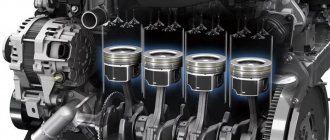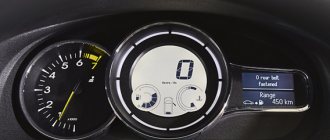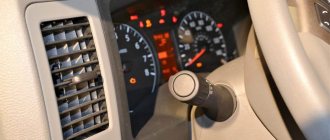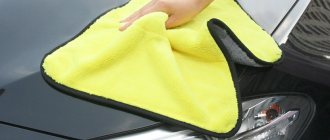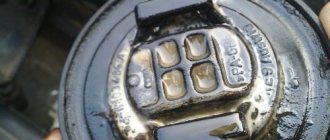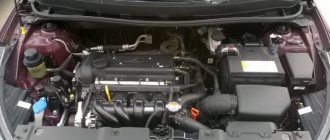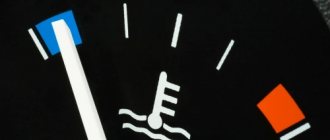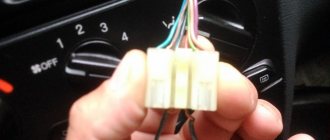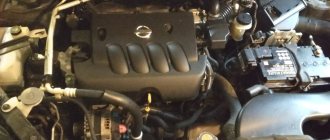Increasingly, car owners decide to undergo such a procedure as washing the engine of their favorite car. It is certainly necessary to clean the power unit, since its condition and durability depend on it. But sometimes after water procedures the engine gives drivers a surprise - the engine stalls or does not start. In order to respond to such a turn of events in a timely manner, it is necessary to understand what actions to take next.
Various problems may occur after washing your car.
Reasons for car failure to start
The reasons why the car refuses to start after washing the engine are mostly similar to faults that cause the engine to trip. The ignition system can only function normally when it is dry. Water, becoming a conductor, promotes charge flow, short circuits and other unpleasant consequences that can worsen sparking.
The starting system of the power plant is also affected by moisture. Most affected:
- Battery terminals. Their gradual oxidation is a natural process. Water that gets on the battery acts as a catalyst. The result is accelerated corrosion and loss of electrical contact. Accelerated battery discharge is also possible due to the formation of a new circuit consisting of water, salts and electrolyte;
- Generator. Entering water can damage it. In this case, after the windings dry out, operability may not return;
- Electrical wiring and other elements of the engine starting system.
Battery terminals
Pouring water into the air filter can cause the car to not start. This creates a risk of liquid getting inside the cylinders. This is fraught with water hammer. After this, an expensive overhaul of the cylinder-piston group is guaranteed.
Ignition problems
One of the common problems that cause tripping is late or early ignition. Also, the engine may stall if the spark plug is weak, which is easy to fix on your own. First of all, you need to unscrew the spark plugs and inspect them in detail. If there is damage to the insulator or other visual defects, the spark plug will have to be replaced.
If the insulator is damaged, it will be visible to the naked eye, because the damage site will be covered with a black coating. In addition, it is necessary to assess the condition of the central electrode and carefully examine the gap of the side element.
At the next stage, it is recommended to check the spark plug wires. If occasional tripping is noticed when driving in rain or high humidity, this unit may stop working normally. The power plant will need to be warmed up and returned to normal operation.
You need to start work with a visual inspection of the spark plug cap and the wire with maximum voltage. Such components are covered with an insulating layer, which dries out over time and begins to crack. This results in current leakage.
High-voltage wires are subject to malfunctions during frequent repair or service activities under the hood. It is almost impossible to determine the defect visually, so you will have to contact a specialist for help.
If the spark plugs and wires are completely intact, the cause of the tripping may be the ignition coil. And if the engine contains separately placed components, the phenomenon will spread to each spark plug. To check the coil, just unscrew the spark plug, apply it to ground and start the engine
It is important to make sure that the thread of the candle fits tightly to the mass and that the cap is securely fixed to the candle. If you do not follow the rules, the coil may burn out and the switch may fail.
If a good spark appears with a bang, you will have to look for another reason for the tripping. If there is no spark, the coil needs to be replaced. The electronic ignition distributor or switch rarely breaks down, so there is practically no need to replace it.
What to do if the car jerks after washing
When the engine stalls after washing, you need to have some kind of action plan (make a checklist) to identify the reasons. But before that, you should once again wipe the motor and wiring dry, blow all areas with air from the compressor, and clean all contacts from plaque. For hard-to-reach places, it is optimal to use compressed air rather than rags.
By the way, in some places the moisture can dry out on its own if you put the car in a dry, ventilated room. Of course, you need to check the spark plugs. This is not difficult to do, but only if you have a spark plug wrench at hand. If the spark plugs are unscrewed, it is better to clean the electrodes from carbon deposits. In addition, it is necessary to wipe the spark plug wells themselves.
Best driving instructors:
Driving instructor Elena Automatic transmission: Chevrolet LacettiTeaches in the Southern Administrative District, South-Eastern Administrative District, Vidnoye, Domodedovo REVIEWS
Driving instructor Marina Automatic transmission: Kia Cerato Manual transmission: Chevrolet LanosTeaches in the Northern Administrative Okrug, Dolgoprudny REVIEWS
Automotive instructor Irina Automatic transmission: Kia Cerato Trains in SZAO, JSC REVIEWS
Driving instructor Natalya Automatic transmission: Kia Spectra Teaches in the Eastern Administrative District, Balashikha, Reutov REVIEWS
Driving instructor Oleg Automatic transmission: Chevrolet Lacetti Manual transmission: Chevrolet LanosTeaches in the Northern Administrative District, Dolgoprudny REVIEWS
Automotive instructor Nadezhda Automatic transmission: Hyundai Accent Teaches in the Eastern Administrative District, Balashikha, Reutov, Zheleznodorozhny REVIEWS
Driving instructor Yana Automatic transmission: Kia Spectra Teaches in the Northern Administrative Okrug, Dolgoprudny REVIEWS
Driving instructor Yulia Automatic transmission: Chevrolet Lacetti Manual transmission: Chevrolet LanosTrains in the Eastern Administrative District, South-Eastern Administrative District, Lyubertsy, Reutov, Zheleznodorozhny REVIEWS
Automotive instructor Svetlana Automatic transmission: Chevrolet Lacetti Trains at Northwestern Administrative Okrug REVIEWS
Driving instructor Tatyana Manual transmission: Chevrolet Lanos Automatic transmission: Kia SpectrTeaches in Krasnogorsk REVIEWS
Driving instructor Peter Manual: Daewoo Nexia Trains at Northwestern Administrative Okrug REVIEWS
Automotive instructor Oksana Automatic transmission: Hyundai Accent Teaches in North-Eastern Administrative District, Mytishchi, Korolev, Pushkin REVIEWS
Driving instructor Dmitry Automatic transmission: Volkswagen Golf Manual transmission: Chevrolet Lanos Trains in North-East Administrative District, Northern Administrative District, North-Western Administrative District, Dolgoprudny REVIEWS
Driving instructor Oksana Automatic transmission: Kia Spectra Manual transmission: Chevrolet Lanos Trains in the Southern Administrative District, South-Western Administrative District, Vidnoye, Podolsk REVIEWS
Automotive instructor Dmitry Manual transmission: Lada Granta Teaches in the South-East Administrative District, Lyubertsy REVIEWS
How to fix the situation
If, after washing the engine, it still starts to work, you need to take action. First, dry everything. Remove the high-voltage wires, individual ignition coils from the spark plugs and blow out the wells. Dry all connectors and treat with a water-repellent liquid, such as WD-40. It just has the effect of displacing moisture from the contacts. If you don't have a compressor on hand to blow it out, you'll have to wait with the hood open until it dries on its own.
How to protect from water when washing
The best remedy is, of course, not to wash the engine. But how to remove oil stains? There are several ways. The most neutral one, which does not lead to consequences, is to buy a grease remover from dishes in a store, spray it on and wait a few minutes until everything drips down. Then use a compressor to thoroughly blow through all engine parts. But no moisture or water.
The second way is to mix a little gasoline with mallow - a product that many car mechanics use to wash their hands, pour this mixture into a spray bottle, spray it on the engine and also air dry.
Elimination of uneven motor operation
Most often, the engine stalls after washing due to water getting into the ignition system. This is where you should start troubleshooting. The following items need to be checked:
- distributor, if present in the ignition system;
- armored wires;
- ignition coil;
- candle wells.
If there is liquid on any of the above elements, it must be removed. When wiping elements, you should visually check their technical condition. There may be situations when, after washing, cracked high-voltage wires or worn-out spark plugs are revealed. If you notice an element that has come out of order, you must replace it without waiting for scheduled maintenance.
It is more difficult to detect water getting inside the cylinders and damage to the sensors. Usually in this case computer diagnostics comes to the rescue. By reading the error log, a specialist can determine why the Check Engine light came on and the engine tripped.
Tips for restoring the performance of the power plant
If cleaning the engine compartment results in the engine being unable to start, the car owner should not panic and immediately call a tow truck. You can correct the situation right on the spot. It is enough to dry the places where liquid accumulates. It is recommended to adhere to the following instructions:
- Open the hood and visually inspect the power plant and other components. Any water found must be carefully removed;
- Remove the terminals from the battery and remove oxides;
- Wipe the high-voltage wires along the entire length;
- Unscrew the spark plugs and let them dry. Make sure there is no water in their planting areas;
- If there is a distributor, it must be dismantled. After this, remove the lid and wipe everything dry;
- Open the air filter housing and make sure there is no liquid in it;
- Check the status of the alarm.
If the above steps did not help, then the malfunction did not arise as a result of the engine being washed, but for other reasons. In this case, it is necessary to begin troubleshooting components and parts. For example, a cracked distributor cap could perform its functions when dry, but the appearance of moisture completely rendered it inoperable.
The main causes of tripling
There are many reasons and factors that are a catalyst for the onset of disruptions in the performance of certain components in the machine. Engine tripping is an unpleasant breakdown, but it occurs with enviable frequency on both outdated and modern models. The reason is vibration or a large amplitude of work that exceeds normal work under similar conditions and circumstances. Even if the car has 8 cylinders, the failure of just one already leads to characteristic problems.
Service station specialists or simply experienced drivers identify the following main factors that can lead to such a violation:
After washing or wiping the engine with a damp cloth, the car starts to shake because as a result of the cleaning procedure, water got into it.
Tribbing occurs due to contact of spark plugs with liquid, which do not produce the spark necessary to start the engine.
Also, problems with the car’s engine may occur due to the failure of sensors (therefore, their performance must be constantly monitored). Sensors are sensitive mechanisms that can break if car shampoo gets into them.
The equipment used in car washes (professional or private) can be the main factor that negatively affects the performance of the motor, since the washing devices operate under high water pressure. That is why it is better not to wash the engine in this way.
When the engine starts to stall after washing, the following is observed:
Increased amplitude of its work.
Constant vibration.
In difficult situations - complete failure of this element.
What and how to wash the engine as safely as possible
If you need to clean the engine yourself, you should follow certain rules.
Please note that you will be working with auto chemicals, which requires increased care and extra precautions (gloves will be needed, and there may be an additional need for eye and respiratory protection). The next step is the need to determine the nature of the contamination of the internal combustion engine. Those contaminants caused by car oil that is caked and covered with a layer of dust cannot be washed off quickly.
It is necessary to apply detergents for the time specified in the accompanying instructions to soften contaminants of this nature.
It is better to immediately abandon the decision to wash the engine under high pressure water with a Karcher if there is the slightest doubt about the advisability of this method. It is quite possible to successfully apply and wash off the applied solution with a brush or a stream of water under normal pressure, but this will require additional time.
What to do if the engine misfires after washing
Increasingly, car owners decide to undergo such a procedure as washing the engine of their favorite car. It is certainly necessary to clean the power unit, since its condition and durability depend on it. But sometimes after water procedures the engine gives drivers a surprise - the engine stalls or does not start. In order to respond to such a turn of events in a timely manner, it is necessary to understand what actions to take next.
Various problems may occur after washing your car.
It’s worth understanding what the phrase “motor troubles” means. Troubleshooting is a malfunction of the engine in which one and four cylinders stop working normally. The consequence of such a malfunction may be an increased amplitude of operation of the power unit and constant vibration. At idle speed, an engine with a failed cylinder will operate unevenly, with dips.
Sometimes when driving with an engine in which only part of the cylinders are working, the car jerks noticeably. Fuel consumption also increases sharply, power is lost, and problems arise with starting the engine, especially when washing the unit in winter.
There may be several reasons why the power unit shakes after washing.
- During washing, water got into the spark plug wells. In this case, due to the presence of moisture, the spark plug cannot produce a spark, and the cylinder, as a result, fails.
- Problems with the engine can also occur due to sensors being damaged after contact with alkaline shampoo.
- Sometimes during cleaning they use equipment that delivers a stream of water under high pressure. Such methods of cleaning the motor can lead to damage to those parts that are vulnerable. For this reason, any car manufacturer defines engine washing using high-pressure apparatus as unacceptable.
Video about possible causes of the malfunction:
If we summarize the reasons for the malfunction of a power unit that has undergone cleaning, then they all boil down to the ingress of water into those parts of the engine that can function properly only in a dry state.
Why does the car jerk at low speeds?
Power system malfunction
Most often, a faulty operation of the power system is the cause of the car jerking when the engine is running at low speeds. The problem is related to the fact that the air-fuel mixture enters the cylinders in the wrong proportions. Accordingly, ignition of such a mixture may occur at the wrong moment, which is why the car will jerk when driving at low speeds or accelerating. It is recommended to check the following elements of the power system:
- Sensors Test the idle speed, mass air flow and throttle sensors;
- Fuel injection nozzles. It is recommended to carry out diagnostics and, if necessary, clean the engine injectors;
- Air ducts for the tightness of the connection between the receiver and the air filter;
- Fuel line connected to the pump. It is possible that there are pressure losses in it;
- Throttle assembly.
If your car has a carburetor engine, you need to check the fuel pump, the carburetor itself, and the idle air valve.
Problems in the ignition system
If there are serious problems in the ignition system, it is unlikely that the engine will be able to start. However, even if the engine starts without problems, it is likely that it jerks at idle precisely because of problems in the ignition system. Most often, the culprit is untimely ignition of the air-fuel mixture or low voltage. You need to look for the problem of the car jerking at low speeds in the following components of the power system:
Sensors Check crankshaft and camshaft position sensors
Please note: If the crankshaft position sensor fails completely, the engine will not start; Candles. Make sure spark plugs do not need to be replaced
By diagnosing spark plugs by soot on them, you can find out about various engine malfunctions. You should also check the spark plug gap to ensure it meets the engine manufacturer's recommendations;
High-voltage wires need to be checked visually and with a multimeter;
The ignition coil should be diagnosed for breaks in the primary and secondary windings, as well as for the presence of external damage.
In rare cases, the problem may be related to the knock sensor, but more often if it fails, the car engine simply will not start.
Gearbox malfunction
It is possible that the problem is related to the automatic transmission. If the machine jerks, it is necessary to carry out a full diagnosis. Most often, problems with automatic transmissions arise after a mileage of 100,000 kilometers, but for each car this figure is individual, and it depends on the operation of the car.
Bad fuel
If the car starts to jerk at low or high speeds after refueling at an unknown gas station, there is a high risk that gasoline that is not intended for it is entering the engine. Simply put, the fuel tank was filled with gasoline with an octane number that differs from the usual value for this engine. In such a situation, it is recommended to drain the bad fuel and refill with new gasoline of proper quality.
The main reasons for unstable engine operation after washing
As a rule, if problems arise with the engine after washing, car owners complain that the power unit is not working. That is, not all cylinders are working. The following signs and symptoms may also be observed: loss of power, increased fuel consumption, problems with starting the internal combustion engine, etc.
Note that there are not so many main reasons why the engine jerks after washing:
- damp candles. Water enters the spark plug well, as a result of which a spark does not occur at the spark plug electrodes.
- It also happens that there is a spark, but it is not powerful enough. If the spark plugs work in this state for a long enough time, they may well completely fail;
- damage to sensors by detergents (if they contain alkali);
- damage to elements in the engine compartment due to excess water pressure during washing;
As you can see, if the car jerks after washing the engine, all problems arise due to errors during the process of removing contaminants, as well as as a result of neglecting basic rules and recommendations.
Most often, drivers strive to wash their car and engine cheaply and with the least amount of effort. To do this, many people prefer to use equipment that creates a high-pressure water jet to wash the engine.
For example, regular car shampoo and Karcher engine wash. The result is moisture ingress, unstable operation of the internal combustion engine or the inability to start it. In the worst case, a short circuit may occur.
Recommendations for washing the car engine
After a properly carried out washing procedure, all engines start and run without problems. Malfunctions occur only when the technology for cleaning the engine compartment is violated or when the car manufacturer’s recommendations are deviated. For example, when using a high-pressure washer, water may get under the seals and cause mechanical damage to the components. Also, for contactless cleaning, car shampoo with a more aggressive active ingredient is used. This in turn causes corrosion of aluminum and copper surfaces.
https://youtube.com/watch?v=BxmP3n4YQIQ
The most gentle way to clean the engine is to use special aerosols. Attachments that are sensitive to moisture should be covered with plastic wrap. To prevent short circuits and damage to electronics, it is recommended to disconnect the terminals from the battery. Spraying should occur on a warm engine. On a cold engine, the activity of the substances will be reduced, and a too hot power unit will lead to rapid evaporation of the cleaning agent. After applying the aerosol, you need to wait 15-20 minutes. It is necessary to rinse the engine compartment with low pressure of running water.
Upon completion of washing, it is advisable to blow out the spark plug wells. For these purposes, compressed air from a compressor is usually used. It is possible to dry using a spray can or a regular hair dryer. Upon completion of washing, it is better to leave the car in a warm garage. This is especially true when operating the machine in winter.
Washing the engine is a mandatory step to keep the engine compartment in order. When cleaning, you should strictly follow the car manufacturer's recommendations and use high-quality products. This will protect the car from unpleasant consequences in the form of a throbbing engine or difficult starting.
Possible reasons
Why does the engine stall? Why does the carburetor shoot? Uneven engine operation can be observed as a result of the following common malfunctions:
- the most common reason is failure;
- incorrect ignition timing adjustment;
- breakdown of high-voltage wires;
- air filter clogged;
- use of spark plugs for purposes other than their intended purpose;
- carburetor not adjusted;
- capacitor failure;
- burnout of pistons and valves;
- wear, breakage, deformation of piston rings;
- violation of operating valve timing;
- high wear on valve rockers;
- air leakage through the vacuum brake booster or intake manifold;
- leaky membrane of the vacuum ignition timing regulator;
- wear of the distributor shaft or rotary plate bearing;
- destruction, breakdown, hardening, wear of valve stem seals;
- breakdown or burnout of the cylinder head gasket.
It is necessary to begin repairs when a non-functioning cylinder is identified. Finding it is not particularly difficult. With the engine running, the tips of the high-voltage wires are removed from the spark plugs one by one. On the working cylinder, after removal, the sound becomes different. If, after removing the tip, the sound remains the same, this cylinder does not work.
Similar articles:
- After washing the engine, the car does not start: possible causes and solutions to the problem
- Car starter malfunction. The most common causes of a poorly functioning starter
- Why does the engine eat oil - causes and consequences
- Why does the car jerk while driving?
Car spark plugs
The main source of the engine trimming at idle speed is the spark plugs. If one of them does not work correctly, the engine will shake - one of the cylinders does not work.
To find out which candle is not working, you can use the old method. Despite the fact that this diagnostic method is ancient, it can be used to very quickly and effectively find a broken spark plug.
You need to start the engine and then remove the spark plug cap from each cylinder in turn. If, when you pull the wire from the spark plug, the engine tries to stall, then the spark plug is in full working order. If the motor does not react in any way to pulling off the cap, then the spark plug in this cylinder is not working.
There is another method. After the engine is running at idle, you can unscrew the spark plugs and inspect them visually. Usually you can identify a non-working spark plug even with the naked eye. It will be filled with fuel. There will also be no characteristic soot on it. The faulty spark plug needs to be replaced and then engine operation will return to normal.
How to quickly find the cause of the problem
In some cases, it is extremely simple to determine the nature of the malfunction, and the same applies to its elimination. The fact is that the car has many warning lamps on the instrument panel. For example, the low oil pressure light came on and at the same time the check light came on. Whether you have an Opel or a Nissan, there is not much difference. Here it is clear that the problem is the lack of pressure in the lubrication system.
The same applies to the cooling system. It has a rather complex structure and is responsible for effective heat removal from the engine. Elements such as a pump are responsible for circulation, and the filler cap maintains a certain pressure in the system. If something goes wrong, the engine heats up and the coolant temperature needle creeps up. When boiling, the “check” will light up. Here, too, it is clear that the problem is in the cooling system, so you need to start with it.
ICE device
The internal combustion engine has a rather complex device that can be equipped with:
- body (block and cylinder head);
- working mechanisms (crank and gas distribution);
- various systems (fuel, intake, exhaust, lubrication, ignition, cooling and control).
The crank mechanism (crank mechanism) ensures the reciprocating movement of the piston and the reverse rotational movement of the shaft.
The gas distribution mechanism is designed to supply fuel and air to the cylinders and to remove the exhaust gas mixture.
The fuel system is designed to provide a car engine with fuel.
The intake system is responsible for the timely supply of air to the internal combustion engine, and the exhaust system is responsible for removing exhaust gases, reducing the noise level from the operation of the cylinders, as well as reducing their toxicity.
The injection system ensures the delivery of TPS to the aircraft engine.
The ignition (ignition) system performs the function of igniting the mixture of air and fuel that enters the internal combustion engine.
The lubrication system ensures timely lubrication of all internal parts and components of the engine.
The cooling system provides intensive cooling of the working engine system during operation.
The control system is responsible for monitoring the coordinated operation of all important internal combustion engine systems.
How to identify a malfunction
The breakdown can be visually determined by the following behavior of the car: if the idle speed is started (not aimed at making the car move), the faulty engine will not operate as intended by the manufacturer. Also, his work may be accompanied by failures.
An additional element by which the malfunction is determined: the car starts, but begins to stall. The more severe the malfunction, the more often such engine stops occur. Even after the factory, the car may begin to twitch noticeably. It is also recommended to pay attention to the presence of the following “symptoms”:
Fuel consumption increases sharply (up to 2-3 times in total for a certain period of road) (gasoline or diesel does not matter in this case). For example: 50 liters was enough to travel 500 km, but after a malfunction occurs, the same amount will only be enough for 300 km.
The usual power is noticeably lost - the declared horsepower is no longer enough for the car to perform usual actions (for example, it becomes more difficult to overcome poorly cleared roads in winter).
There are problems starting the engine.
In 90% of cases, problems after washing are observed in the cold season or in regions where the climate is unstable. In most cases, frozen water leads to the formation of ice, which also negatively affects overall performance.
Nuances and important points: why wash
If there are problems, then after washing (professional or self-washing) there will be a deterioration in performance - the car’s engine will begin to stall. As a result:
The car will stop starting.
It will stall on the road.
It will stall after factory.
It won't start the first time.
The problem needs to be fixed as quickly as possible so that there is no need to overhaul the engine or replace it.
Is it necessary to wash the engine?
There are many opinions and rumors regarding this issue. There are always pros and cons, pros and cons. One of the reasons why the engine is washed is heavy leaks of oil, antifreeze, or antifreeze. The biggest cause of this, of course, is the oil sludge on the engine. It interferes with normal cooling in the summer and the engine overheats. To see and then eliminate where the oil is leaking from, it’s a good idea to wash the engine in a car wash with special chemicals and knock it all down under pressure with water. Coolant corrodes contacts, engine harness wires, electronic control unit and other electrical components of the internal combustion engine, which can adversely affect the operation of the engine.
If the car is often driven outside the city, in the forest, or on rough terrain, dirt sticks heavily to the engine, cooling fan, and radiator. If you don’t knock the clay off the fan in time, it will create vibration and simply break the bearing over time, and you’ll have to replace it. And the cost reaches, especially on foreign cars, colossal amounts.
This way, you can be sure that engine washing is necessary in some cases. But doing it just for the sake of prevention, or against dust, makes no sense. After all, the price of such a procedure can result in tens, or even 100 thousand rubles. One of the expensive components in the engine compartment is the electronic engine control unit. Its cost is measured in tens of thousands of rubles, it all depends on the make of the car. The second most expensive part and the most risk of failure is the ignition coil. It's not cheap. Why are these expensive parts listed in the engine compartment? The thing is that when washing the engine, the car starts to misfire, precisely because of them.
No spark
Since a high-pressure apparatus is used when washing the engine, the amount of water it produces is enormous. Some of it ends up in spark plug wells on sixteen valve, two shaft or more engines. Car owners, of course, do not suspect this; they start the engine, the coil begins to spark through the water onto the engine ground and immediately closes. If in such a situation you do not turn off the engine and drive further under load, the coil can pierce the primary circuit so much that reverse current flows towards the electronic control unit and burns through the transistor that controls the coil and nearby circuit board tracks. Then the brain cannot be restored; you will have to buy a new one. It's not a cheap purchase and most cars don't have them in stock.
Often, when selling a car, the engine is washed in order to hide oil leaks, or simply for beauty in order to sell it at a higher price. For example, on vases with an eight-valve engine, the ignition coil, which is located opposite the cooling radiator, is immediately filled. It strikes a spark and covers high-voltage wires and spark plugs along the chain. It is rare, but there is a breakdown of the ECU itself, as described above.
Thus, when water gets into the spark plug wells after washing, the engine shakes and the car jerks violently. Until the water is removed from there and the broken parts of the high-voltage circuit are replaced, the motor will operate unstably. After washing the engine, you can leave the car with the hood open for a while and wait until all the parts dry. The best option, of course, would be to blow the engine with air from the compressor.
Action of alkali
Shampoos for washing cars and engines have a powerful alkaline composition that is designed for oil and fat deposits. He washes them off in one go. But when they wash the engine with it, contact also occurs with the plastic of sensors, high-voltage wires, and ignition coils. The composition of the product begins to corrode, especially on older cars, the wiring and short circuits appear, which leads to tripping, and worst of all, when the car does not start.
How to fix the problem and what the driver needs to do
Since the main cause of a malfunction in the form of tripping is water, the first thing the driver should do is try to remove it as quickly and thoroughly as possible from the surface of the engine or spark plugs. It is important to remember here that the work must be carried out in a sink. Stages:
You need to park the car in a dry place (the optimal solution is in a warm garage).
Then wipe all existing electrical wiring of the machine.
Wipe the spark plugs thoroughly (in most cases, this is the point that car enthusiasts miss).
Finally, it is necessary to check the battery terminals in order to ensure the functionality of this element.
What to do before contacting the service
An experienced driver or a novice should take into account that in some cases, a layer of dirt formed on the terminals, which has a pronounced dark color, causes the engine to start shaking after washing. It is eliminated with water, which leads to a malfunction. That is why it is important to wipe the terminals dry after cleaning and carefully tighten them.
It becomes more difficult when after washing it turns out that water or condensate particles, elements of car cosmetics or other liquid components have penetrated under the hood. In this case, it doesn’t matter at all how the washing was done: independently or by professionals, because such a nuisance can happen to anyone. In order to eliminate the consequences of moisture or condensation penetration, you will need:
Turn off the car (turn off the ignition).
Turn it on again (check operation).
In 90% of cases, after cleaning using any liquids and even shampoos, violations are present there.
If you have an ignition distributor, you will first need:
Disassemble the distributor.
Remove residual water and moisture under the lid.
Additionally, wipe the armored wires.
Check the spark plug windows to ensure they are completely dry.
If the presence of water in the spark plugs is detected, it is not recommended to start the engine with choke. Such an action will not have the desired effect (it will not stop tripping). When blowing spark plugs, it is best to remove the choke, then squeeze out the gas and only then start the engine.
Ignition works without distributor
It also happens that the car has an ignition without a distributor. In this case, to restore functionality, the car owner will need:
Unscrew the coils (all of them).
Remove them to make them easier to work with.
Blow them out.
Wipe so that the spark plug wells are dry.
It is recommended to lubricate wires with a high voltage rating with a special compound called WD-40. This will make it possible to maintain the functionality of the engine with the maximum probability after washing.
Additional recommendations
If the engine troubles significantly after washing, even after the measures taken, it is recommended to pay attention to the following:
are there any cracks or deep chips in the distributor body;
What condition are the electrical wires of the car?
The engine can also be damaged after washing only from the outside.
Timing problems
It must be taken into account that after contact with water, the timing belt may break. A quick knock of the starter will help determine the malfunction. If a break does not occur, but there is a knocking sound, then the problem may lie in problems with the ignition spark supply or with the carburetor (if the car has one). Electronic ignition should not be overlooked, since after contact with water the engine may start to troit and the car may stall while driving.
Tags
cause of malfunctions afterOther malfunctions review of engine malfunctionsvarious malfunctions of such malfunctions canOther malfunctions of such malfunctions occuridentify the malfunction identify the malfunction with the malfunction will be shampoo sensors came outdamage to sensors with washable sensors.on sensors.shampoo sensors came out similar sensors.failure of sensor.damage to sensors.damage to sensors by washing ECM sensors
gas injector indicatorexhaust steam control position
Let's sum it up
As you can see, if after the driver has washed the engine, the car jerks, in the vast majority of cases the moisture that has got into the spark plug wells, high-voltage wires, ignition coil or distributor is to blame.
Also, do not use alkaline solutions or detergents containing other aggressive substances to wash the engine, which can damage the ECM sensors, insulation or disrupt the operation of individual elements. You should never wash the engine with a high-pressure water jet without preparing the car.
Finally, we note that after washing the engine it is better not to try to start the engine immediately. Before starting the engine for the first time, it is necessary to thoroughly dry the spark plug wells, check the spark plugs and contacts, and blow out all hard-to-reach places with compressed air.
Then you need to close the hood, after which it is better to leave the car for some more time (preferably overnight) right inside the car wash. As a rule, during this time the moisture will evaporate from hard-to-reach places (provided there is no strong humidity in the room itself), after which the engine should start and continue to operate without problems.
What can be considered normal and what not?
It is not always necessary to fall into despair and panic. The fact is that in some cases the problems are not significant, and sometimes there are none at all. A striking example of this is self-diagnosis of the system state. It is performed when you insert the key into the ignition and turn it to the operating position. In this case, the “check” should be lit. It usually goes out either after a few seconds or after starting the engine. At this time, all the dashboard lamps should light up, which indicates their serviceability.
Many people don’t know about this, this applies, of course, to beginners
If you started the engine and everything was fine, and after some time problems appeared, you need to pay attention to the ECU. It is likely that due to its unstable operation the “check” lights up
Toyota of the latest models allows you to perform self-diagnosis of the ECU and determine exactly what the problem is.
What systems is the ECM responsible for?
To understand the problem in more detail, you need to understand where to go. So, a modern electronic control unit reads information from the following systems:
- cooling;
- nutrition;
- lubricants;
- exhaust gas removal;
- ignition
The most common problems are with engine cooling and lubrication. For example, a faulty thermostat will lead to rapid overheating of the internal combustion engine. If the driver is not informed about this in the form of an appropriate signal, then you can find out about it when steam comes out from under the hood, but in this case it may be too late.
Try to check the engine oil level, the condition of the cooling and power systems as often as possible. All this should work if you don’t want to meet “Jackie-Chan” one-on-one on the track at night.
